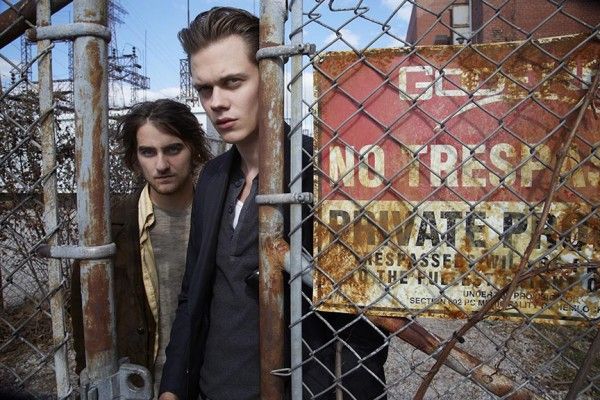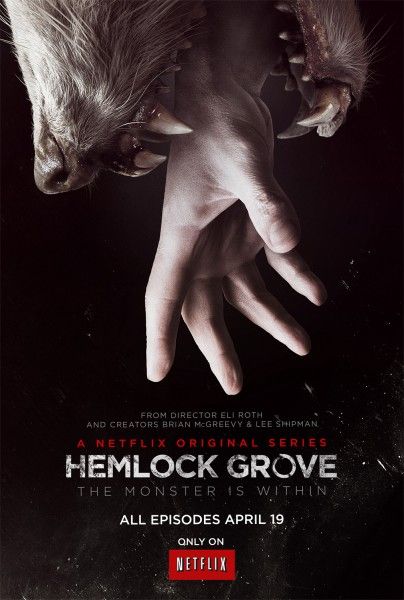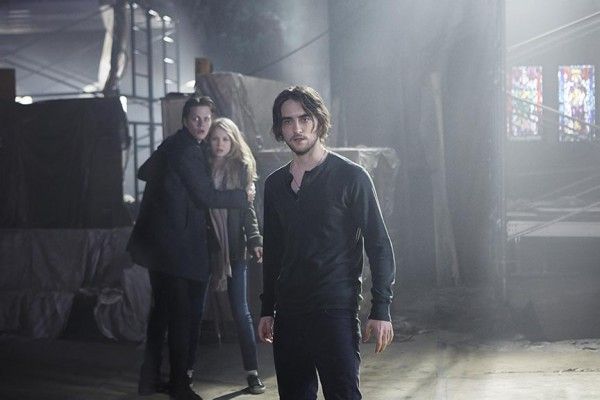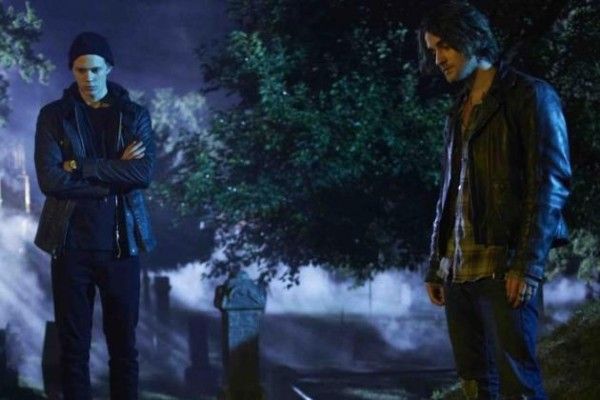Hemlock Grove, based on Brian McGreevy’s novel of the same name, puts a spin on the current trend of werewolves and vampires, replacing love triangles with body parts and unconsummated longing with raunchy, bloody sex. The story picks up in the small town of Hemlock Grove following a string of grisly murders when new boy in town, Peter Rumancek, gypsy trailer trash and rumored werewolf, comes under suspicion for the crime. Peter finds an unlikely ally in Roman Godfrey, golden boy of the wealthy and influential Godfrey estate, Hemlock Grove’s resident wealthy philanthropists in the model of the Carnegies. Together the pair attempts to solve the mystery of the murder before the killer can strike again. The show stars Famke Janssen, Dougray Scott, Lili Taylor, and Bill Skarsgard, Landon Liboiron.
Shortly before the WonderCon panel (here's my recap), executive producer Eli Roth and director Deran Sarafian sat down for a roundtable interview. We talked about what attracted Roth to the TV format, what they loved about the book, creating a unique werewolf transformation, balancing the gore with good story, Roman and Peter’s Unique Relationship, and more. Check out the full interview after the jump. Please be aware that there are minor spoilers for the first three episodes.
We’re very excited about your series.
ELI ROTH: So are we, it was a crazy, fun, exciting thing to shoot. I’ve been wanting to get into television for a while, but there was always an inherent problem that I couldn’t solve, which is that what makes horror great is that anyone can die at any second, but what makes television great is that you have characters that you love that you come back to see week after week. As things started evolving in television you get The Walking Dead, Game of Thrones, and Boardwalk Empire, and you can see these very violent stories playing out over a long period of time. You could feel the medium was evolving. Then of course what Ryan Murphy did with American Horror Story was terrific. It was the producer Eric Newman, who I did The Last Exorcism with, who brought me the manuscript of Hemlock Grove, and when we read it we thought, “This is it, this could be like a monstrous Twin Peaks.” It’s a murder mystery. It’s about something rising from the ashes of steel town America. We pitched it to Netflix and they were so excited to go for it, and we loved the idea of doing something new that was bold and different, but having every episode available to you and really approaching it like a 13 hour movie.
Then of course working with Deran, it’s so great when you have somebody who’s so experienced in television and feature films, and comes from the feature world. Very few people know this about Deran, but he actually cut his teeth, in his twenties, working under Dario Argento and Lucio Fulci, shooting second unit for those guys and even acting for them. So when we talked about things like the werewolf transformation, the attacks and the kills, we knew that he was going to photograph the dramatic stuff to look beautiful and fantastic, but he cared about the horror scenes the way I did, and he was just a perfect creative partner.
DERAN SARAFIAN: I’ve been a big fan of Eli’s before this even started and once I had the opportunity to work for him I just went for it. We have a similar agent and I said, “Get me in there with Eli, let me work something out, I feel like I know the guy.” We sat down, we started talking and we just hit it off. We have very similar sensibilities; I see it in his work. Very, very similar. When we started this he goes, “Listen, I want to do something that is reminiscent of great horror, but I want to twist it.” He brought up Lynch and people that we all aspire to be like, because it’s like looking at a Picasso, we want to be like that. We got into this with the mindset of twisting this and making it different. Something that Eli told me early on that we sort of tried to follow is if you look at a rock, don’t film that rock, film what’s beneath that rock, which has been really, really fantastic.
ROTH: There’s a whole world going on under there; rot, worms, disease.
SARAFIAN: Exactly; I just thought it was brilliant and it just gets more under that rock as the series goes on.
ROTH: Yeah, it gets darker, and Brian wrote such a wonderfully twisted novel. I was so impressed with his research, and in particular his research about the root mythology of what Bram Stoker based Dracula on, Upirs and Vargulfs. It’s literally the original folklore that the very first novels were based on, but setting it in this world where biotech has risen out of the ashes and these new monsters have been created, using them as a metaphor for teenagers and all those things. It was a very, very dark twisted novel that’s unapologetically so, but still fascinating and strange. We talked about that transformation and how we were going to pull it off and we sat there for weeks. For me the benchmark was always An American Werewolf in London, the Rick Baker transformation, but I also love the Rob Bottin transformation from The Howling. We thought about if you’re a fourteen year old girl, your idea of a transformation is a shirtless guy who walks around a tree and comes back a wolf. I want people to watch it and go, “Oh, that’s what it’s really like.” A violent birth and visceral, he eats the placenta, and then Deran was like, “Yeah, then he should shake it off like a wet dog!” Both of us just went to town.
SARAFIAN: I wanted it to feel like an orgasm. It’s the same thing. I want this thing to be personal.
ROTH: I remember Deran was like, “You got to pound your fist into the ground.” It was so brilliantly rendered, and it really was Deran’s years of television experience and horror experience, and his artistic eye that we were able to pull that off. You’re shooting an episode in eight days, we could have spent eight days shooting that transformation, and I know how to do it from my feature films, but Deran has so much experience. And because we’re not airing every week he was able to shoot the transformation over the course of ten episodes and put it in episode two, because they’re all going to air at once. That way if there’s something we want to change in episode one, we just do it. We really got to approach it like a thirteen hour movie.
SARAFIAN: If this transformation wasn’t good, if we didn’t feel great about it, it’s almost like Texas Chainsaw Massacre when Leatherface took the girl and hung her on the hook.
ROTH: Yep.
SARAFIAN: This is our moment to make you go, “This is not your normal horror series.”
You took a different approach to the relationship between your two male leads as well. Roman and Peter, rather than butting heads, they have almost an instant bond.
ROTH: I love when you really play out long term mythology, like in the early X-Men movies when they’re working together and you’re like, “Oh that’s so cool, Magneto and Xavier we’re friends, they worked together.” You want to see the moment where they split apart. Of course you want to have somewhere to go in season two and season three, so if you start them off as enemies, where do you go from there? Starting them off as friends that work together then slowly these other sides of them can come out. That’s the great thing about a story like this, Brian has three novels already written, so he’s got these character arcs that he can go back and remember how things were. It’s like your relationships and your friendships; some of them might have been your best friend three years ago and you might not even be talking to them now. So it’s fun to be able to play that out over different seasons.
Was there discussion about how much you would take advantage of this format where you can really run with the gore? The elements of gore that we’ve seen in the first three episodes are intense, but they’re pretty sparing.
ROTH: Absolutely, normally restrained is not the word associated with me, but we also wanted people to get into the story and we didn’t want to be like, “Hey look, we’re on Netflix, we can rip someone’s guts out!” We could have done that, but I think you then become very self-conscious about it. The gore is like an ingredient in a pizza, it all has to serve the story. If you’re watching and go, “What happens next?” That’s the right amount.
SARAFIAN: We wanted to be the shark under the water, we really did. That’s the whole idea. The sexual tension between the two lead characters- I mean this is a love story, really, if you look at that novel, this is a love story between these two guys and that’s what we wanted to go after. The ad campaign is so right on; “The monster within.” We didn’t want it to be just a big monster show. When we read the book, and we talked about this, what our hero David Lynch really did so well was get into the duality of who people are, what they’re all about.
ROTH: Nobody is who they seem, everything is under the surface, but also there was the cold sterility of an isolated, wealthy world that Hal Ashby did so well in films like Harold and Maude where these people with money in these gorgeous, old houses have the saddest life. We kept talking about, what does Roman do? He’s sits there in a drained tub with slippers on, listening to music, smoking cigarettes, whereas Peter lives in this trashy trailer, but it feels warm, it feels cozy, it feels like everybody could hang out there and be comfortable. Roman’s house is like a strange, sterile museum. We didn’t want it to be all about making a gory show; we wanted to create a world.
SARAFIAN: It’s funny you say that because it was a museum and we were lucky enough, in Toronto, to shoot in this place called Parkwood Estate, it was a real museum and they let us film in there.
ROTH: There was a bowling alley, it was crazy.
Click here for all our Hemlock Grove coverage. And here's everything we've posted from WonderCon 2013.




